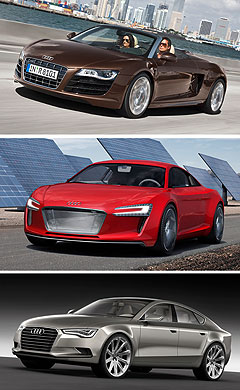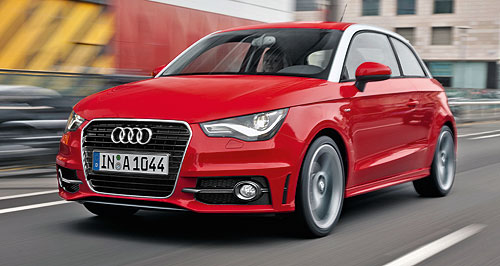News - AudiAudi has 20/20 visionA1 growth: Audi's A1 small car - seen here in Worthersee Tour customised colours - will be crucial to Audi's future in Australia, according to new MD Uwe Hagen. First there was Route 15, now Audi has Strategy 20208 Jun 2010 AUDI’S new Australian chief says the company remains ahead of its target to become the world’s biggest luxury car-maker, and will introduce 15 new models by 2015 as part of a new business model known internally as Strategy 2020. According to Uwe Hagen, who made his first official media address as Audi Australia’s managing director today in Sydney, Strategy 2020 encompasses all of the goals of its previous business model, Route 15, which calls for 1.5 million global sales and 15,000 sales in Australia by 2015. In a change of pace from his predecessor Joerg Hofmann, however, Mr Hagen said increased sales volume over that period – which will spring from a raft of new vehicles, including the volume-selling A1 compact – was not the most important part of the Audi business model, which would not sacrifice profitability for sales numbers. Mr Hagen said it was “possible” Audi Australia could achieve 15,000 sales two years earlier than planned in 2013, as forecast by Mr Hofmann, but stressed that he preferred to focus on other aspects of the Route 15 plan, including profitability and customer satisfaction. “Our clear target is to become the premium market leader,” said Mr Hagen. “And we are ahead of our targets in Australia. I can’t give you a number of what we will achieve in 2015, but it will be more (than 15,000). “Route 15 is still our main strategy and we are in line with our volume target to achieve constant and profitable sales of more than 15,000 sales and to have the benchmark dealer network. “The way our dealers have spent money is exceptional. Dealers have spent $170 million in new facilities. It is the foundation for the future. The largest Audi terminal up to now worldwide is in Sydney. We’re confident we’ll get a return on investment in future. “With new products next year we see a huge chance to gain even more volume and share in Australia.  From top: Audi R8 Spyder, Audi e-Tron concept and Audi A5 Sportback. From top: Audi R8 Spyder, Audi e-Tron concept and Audi A5 Sportback.“If you compare Australia to other markets you were really lucky the economic crisis didn’t hit as hard, but there was an impact. It spoiled us a little bit. “Despite the weak economy we were able to show the strength of the brand in Australia. But (sales) volume is not the only important point. “If you try to convince an investor, it is by telling him he will make money, not by telling him he will sell cars. We want profitable volume, not just volume. “Selling one car more than the other brand doesn’t mean anything. Profitability is key.” Mr Hagen said the 6.5 per cent return on investment (before tax) achieved by Audi AG last year was a benchmark for the entire industry, but that the Australian subsidiary’s 2.0 to 2.5 per cent return on investment was still better than in Germany, where the average return on investment for Audi dealers is less than one per cent. “Audi recorded a €1.6 billion profit last year – more than any other brand, including Volkswagen,” he said. “We are profitable in Australia too. We are a good part of the business. We handled the crisis better than most. “We made a reasonable profit result in a year when a lot of companies made a loss.” Globally, Audi AG sold 949,729 vehicles in 2009 – 5.4 per cent down on its 2008 high of 1.003 million sales but better than the 900,000 sales it originally forecast. Australia was the fourth fastest growing market for Audi (behind China, Austria and Japan) and one of 38 markets in which it grew worldwide last year despite the economic downturn. Audi sold 11,310 vehicles in Australia last year – up 20.2 per cent on 2008 figures. Its Australian growth rate continues to outstrip that of both BMW and Mercedes-Benz, which so far this year are up 17.4 and 19.4 per cent respectively while Audi sales have surged by 31 per cent in the same period. Audi plans to sell more than 12,000 vehicles in Australia this year – its sixth consecutive year of growth – but BMW has sold more than 17,000 vehicles here for the past two years and recently targeted no fewer than 20,000 sales by 2015, while Mercedes sold more than 19,000 cars and commercials last year for the first time. The new Audi Australia chief, whose previous role was sales manager for western Germany, said Australia plays an integral role in Audi’s global sales strategy. “It’s a challenge to come to a new country,” he said. “My first weeks have been really, really exciting. I’ve seen most of Australia in short visits and am really impressed with what I see. “We had a huge success here and that brought us to number four. Audi is proud to have a team in this market, including dealers, that has a done a really good job. It is a statistic that our board is really very proud of. “We have a clear strategy and the success shows we’re on the right path. We have a lot of good product to launch.” Audi plans to add 15 new models between now and 2015 (from 27 currently to 42), starting with the all-new A8 limousine in late September and also including a range of new niche models such as the S5 Sportback and R8 Spyder in October. While the topless R8 will help reverse a 68 per cent sales slide for the top-end sportscar this year, the S version of the A5 Sportback will boost sales of the A5 beyond the 77 per cent increase it has already posted this year. The facelifted Q7 will arrive before the end of the year to replace a volume-selling Audi model whose sales are down 13.4 per cent year to date, but Audi’s next significant sales growth will occur in 2011. The first quarter of next year will mark the arrival of Audi’s smallest model, the three-door A1 hatchback, which is set to arrive here with at least two engine choices and a starting price to compete with the Mini and Citroen’s forthcoming DS3. Audi Australia marketing general manager Immo Buschmann confirmed the A1 would be priced to compete with the Mini, which opens at about $32,000. Model for model, he said the A1 would undercut the three-door A3, which opens at $34,700 as an automatic. Leaving the door open for the A1 to be more expensive than the A3, Mr Buschmann said Audi Australia had yet to decide the launch engine line-up for the A1, which is likely to include a diesel model. The A1 will be launched to European media next week, before going on sale there next month. “The A1 is the most important thing of all,” said Mr Hagen. “It is the centrepiece of our range and I’m totally convinced it’s the best car in its segment, but we have to convince our customers.” Later next year Audi’s Sportback concept will morph into a production version of the A7, which will arrive as a larger stablemate for the A5 Sportback to compete directly with the Mercedes-Benz CLS and BMW’s forthcoming 6 Series four-door ‘coupe’. Further afield, Mr Buschmann said Audi was yet to decide which model will debut its plug-in hybrid technology, which was previewed in both the e-Tron sportscar concept and the A1 e-Tron. “Between 2010 and 2012, Audi will spend €5.9 billion in product development. That’s a clear sign of confidence,” said Mr Hagen, who added that new Audi dealerships in Bendigo and Shepparton would complete the brand’s new-look national dealer network this year.
 Read more6th of May 2010  Audi shows seven new A1 variants as UK sales openSeven wacky versions of Audi’s new baby preview a Mini-matching A1 options list8th of March 2010  Uwe Hagen to drive Audi Australia forwardBig job ahead of Audi’s new boss as German brand strives for 15,000 sales by 201023rd of February 2010  Geneva show: New Audi RS5 aims straight at BMW M3Audi-BMW fight ratchets up a notch as RS5 coupe targets M3 with mad 331kW V8 |
Click to shareAudi articlesResearch Audi Motor industry news |
||||||||||||||||
















Facebook Twitter Instagram